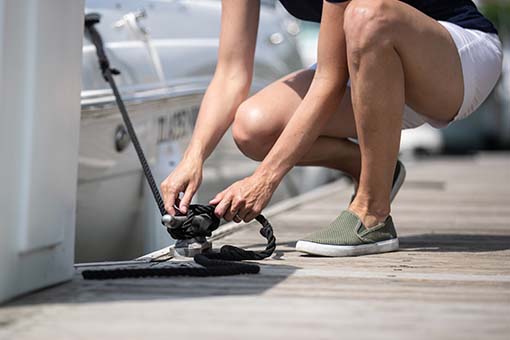
Every boater needs dock lines, and choosing the best ones for your boat is vital.
Some boaters like to go to waterfront restaurants for a dock and dine, others rent a transient slip for a weekend getaway aboard, and still others choose in-water boat storage in a slip. In all these very different cases, boaters share a common need for dock lines.
Since dock lines are the only thing keeping your boat from drifting away, it’s fair to say that choosing the best dock lines for your boat is a rather important decision. In today’s blog post, we’ll cover how to pick the perfect dock lines for your boat – and the exact steps to follow.

Before diving into the marine ropes process, it's important to research differences in rope for boating so you understand why you’re picking each one.
Essentially, nylon stands out as the most popular choice for boat ropes due to its strength, UV resistance — and most importantly — its stretchiness. This flexibility is essential for situations where rocking or tides eliminate slack from the lines. And unlike Dacron (strong but inflexible) and polypropylene (vulnerable to UV and chafing), nylon offers a perfect blend of properties for dock lines.
Although some studies have proven that polyester may be better suited to hold up during storm weather, they’re usually used as dock lines for much larger boats.
Next comes the choice between three-strand and braided nylon lines. Three-strand is more affordable but stiffens over time, making them difficult to use with cleats. Braided lines, although slightly more expensive, are far easier to handle due to their suppleness and come in a wider variety of colors.
Additionally, consider pre-spliced loops at the end of the lines for added convenience. These loops simplify securing the line to pilings or cleats, especially in challenging weather conditions.
Fortunately, picking out dock lines of the proper size is simple. As a general rule of thumb, 3/8” diameter dock lines are appropriate for boats up to 25 feet. From 25 to 35 feet, 1/2" dock lines are the right pick. For 35- to 45-foot boats, opt for a 5/8” line. Larger boats will need 3/4" thick lines, and yachts may need even thicker dock lines.
Additionally, it’s good always to have lines about the length of your boat aboard for transient docking or for tying up temporarily for a meal, snack or short stay. Lines that are too long may be inconvenient, but too short lines can make docking impossible, so erring on the longer side is always a good move. You can also carry extras onboard.
And remember, many waterfront venues do not have extra lines on hand, so if you want to enjoy those experiences, you need to keep those dock lines aboard.
When choosing your marine rope (braided or three-strand), keep in mind that the working load limits (WLL) of dock lines can vary with size and material. Also, people should check boat ropes regularly for chafe or sun damage, unraveling, and other signs of wear. And if found, they should be replaced before they become a liability!
If you’re mooring a boat in a wet slip, lines usually need to be about 2/3 the boat's length. This can vary, however, depending on the size of your boat, the size of the slip, and the placement of the pilings. (Note that permanent dock lines used for mooring may also need chafe protection.)
Again, wet slip situations can vary quite a bit, so each situation has to be treated on a case-by-case basis. For transient docking, the general guidelines are to have dock lines around the length of your boat for more convenience.
The minimum recommendation for dock lines is four for bow, stern, and spring lines. This might suffice in some wet slips, but configurations can vary. (You might also need additional spring lines for specific situations.)
For a well-equipped vessel, six lines are ideal: two bow and two stern lines, each at least two-thirds the length between your boat and the dock, and two spring lines the length of your boat. And remember to factor in water level changes and leave extra slack in the lines to avoid them becoming too short!
No matter what type of boater you are or what type of boating activities you enjoy, keeping dock lines on hand is a must. Make sure you choose the best dock lines for your needs, and your days on the water will be much more enjoyable.